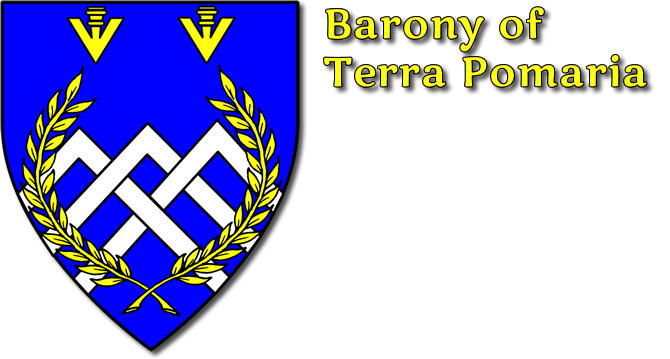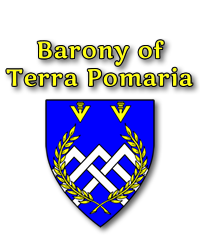19 May Of honey boiled with walnuts, known as Nucato
Then Serve It Forth…
By Lady Rosemary Willowwood de Ste. Anne
Plenty of tasks in the busy spring, including some that ensure plenty and sweetness in the later part of the year. Thomas Tusser cautions in his “Five Hundred Points of Good Husbandry” that the farmer should “Take heede to thy bees that are ready to swarme, the losse thereof now is a crownes worth of harme: Let skilfull be readie and diligence seene, lest being too careless, thou losest thy beene (bees).” Digbie is one of the few recipe collections that uses a great deal of honey, and that is mostly for brewing. So, I will take us a bit farther afield to Italy for a taste of honey.
“Of honey boiled with walnuts, known as Nucato”
From Libro della Cucina del secolo XIV
Franceso Zambrini, ed., Bologna, 1863
Dele mele bullito con le noci, detto nucato: Togli mele bullito e schiumato, con le noci un poco peste e spezie cotte insieme:bagnati la palma de la mano coll’acqua net estendilo: lassa fredare a dà a mangiare. E puoi ponere mandole e avellane in luogo di noci.
TRANSLATION: Of honey boiled with walnuts, known as “nucato”. Take honey, boiled and skimmed, with slightly crushed walnuts and spices, boiled together: Wet the palm of your hand with water and spread it out; let it cool, and serve. And you can use almonds or filberts in place of walnuts. (Since I speak only a word or two of Italian, this translation is courtesy Edward Schnieder, taken from The Medieval Kitchen – Recipes from France and Italy, by Odile Redon, Françoise Sabban, & Silvano Serventi (University of Chicago Press, Chicago, 1996. A truly marvelous resource!)
REALIZATION: I recommend that this recipe be made with almonds, at least the first time. The light color of the nuts allows a better measure of the color of the honey, which is the measure of “doneness” of the candy. This ingredients for this recipe should be measured by weight, not volume. Measure equal weights of honey and almonds. Two pounds of honey is a good place to start; this will be just under three cups, but use a scale to be accurate. Place in a heavy saucepan over medium heat. Bring to a gentle boil, skimming any foam that rises. Once the honey boils, it should be stirred almost constantly with a wooden spoon. Add an equal weight of blanched whole almonds and a GENTLE shake of cinnamon or ginger; Cloves are much too emphatic here. Cook until the honey darkens; the almonds will begin to brown, and may begin to pop. You are shooting for a temperature just above hard ball, and just below soft crack. Check by dropping a drop of the honey into cold water. The ball that forms should be malleable, but very firm and easily picked up with the fingers. Once the honey starts to darken, watch carefully! A moment’s inattention may lead to burnt honey and a ruined pan. Pour the finished candy into a generously buttered pan, spreading into an even, but rather thick layer. I recommend against the trick of trying to use a wet hand to spread the hot candy. The authors of The Medieval Kitchen suggest a clever alternative of spreading with the cut surface of a lemon, which prevents blisters and adds flavor. When cool, cut into small squares with a sharp heavy knife. The pieces may be rolled in cornstarch to minimize stickiness.
This recipe is exactly what in modern times the southern French, Spanish, and Italians call “black nougat” (see glossary). In Provence in France, it is made with lavender honey and no spices. In Spain, they sometimes add grated orange peel instead of spices. In Italy, as indicated in the recipe, they vary the nuts. A more modern type of nougat is “white nougat”, made much like divinity by whipping the boiling honey syrup into stiffly beaten egg whites, then stirring in the nuts. (The earliest dated recipe I could find for the white variety was the early 1800’s.) Several cultures use the trick of pouring the hot nougat into a pan lined with edible rice paper, placing another sheet of rice paper on top, and then weighting the top with a board cut the same size as the pan. The rice paper isn’t easy to find, but is occasionally in oriental markets, or a confectionery supply.
An interesting use of the black and white nougats are in the thirteen desserts served as the conclusion to a traditional Provençal Christmas dinner. I was unable to find dates for this, but given some of the symbolism, it could easily extend back into the SCA period. The Provençal Christmas dessert consists of thirteen dishes, representing the twelve apostles and Jesus. The first four plates are for the great religious orders: almonds for the Carmelites with bare feet; figs for the Franciscans; raisins for the Dominicans; and walnuts for the Augustinians. Then came four plates of fruit: apples, pears, oranges, and melons. Finally cane a plate of five desserts: quince jam, dates, a savory bread called “fougasse ou pompe à huile” stuffed with anchovies, garlic and olive oil (loaves and fishes in a single packet!), and finally black nougat and white nougat, symbolizing black for sin and white for purity.
Absent tradition, one might wonder why, in most of the surviving French and English collections, recipes for honey candy are a rarity. My own theory is that most of the recipe collections are for the courts of the rich, not the poor. By and large, honey was thought of as the sweetener of the poor, since anyone with the talent could capture a swarm, and bees are not respecters of rank or privilege. Use of sugar (which was expensive and imported) was another sign of conspicuous consumption, like use of spices. Finally, raw honey takes considerable time and trouble to clarify for use, which anyone who has made hydromel or any other honey brew can testify. Cooks whose employers could afford sugar would surely have appreciated the break! Almost every recipe I have seen where honey is mentioned as an alternative to sugar casts it in the light of a poor second, only to be used if you have no other choice.
One last warning: I take no responsibility for casualties incurred by fillings or caps on teeth. The stuff is delectable, but care is advised!
GLOSSARY:
Nougat: A sweetmeat made largely with honey and almonds. Webster’s Collegiate Dictionary gives the following derivation: “French, from Provençal, from Old Provençal nogat, from noga nut, from (assumed) Vulgar Latin nuca, from Latin nuc-, nux- or nut.” Generally made in two varieties, “black nougat” made with honey and nuts only, and “white nougat” made with the addition of beaten egg whites.



